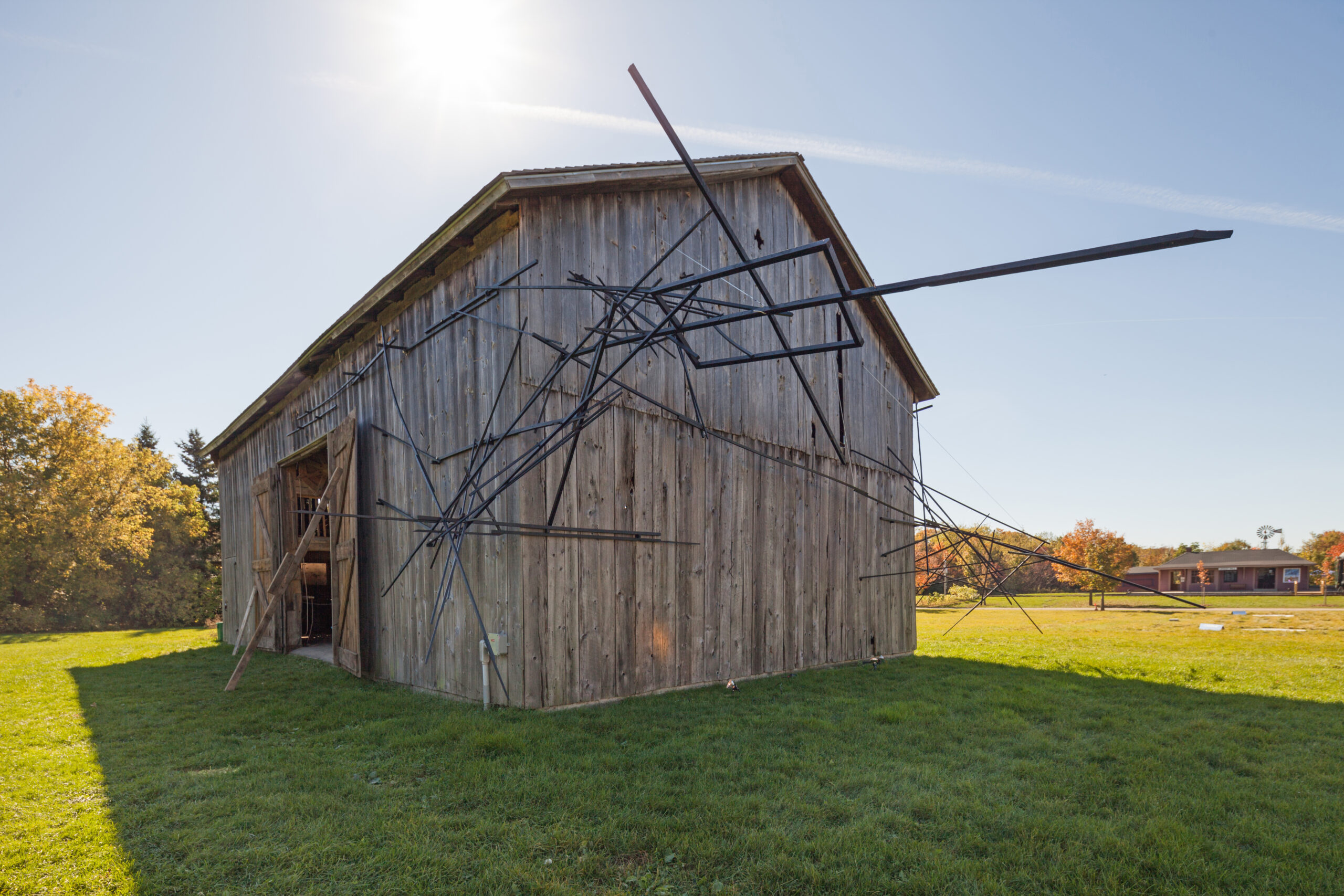Is the human ingenuity of pioneer spirit that created this rural life and the hoists the same force that is now destroying it 150 years later?
The Markham Museum lies on the edge of the former pioneer village of Markham, which has long been annexed by Toronto. Just like other villages in the vicinity, Markham still has s historic centre but the largest part of its territory is taken up by semmingly endless and uniform new suburbs.
This is presently the fastest growing urban area in Canada and perhaps even in North America. It is remarkable that large parts of these new towns are populated by Asian immigrants, mainly Chinese, who buy not just a house but also the freedom associated with moving to Canada.
year: 2013
location: Toronto, Canada
dimension: 1830 x 1169 x 716 cm
material: recycled construction plywood, square timber, rope
exhibition: Land|Slide Possible Futures, June 28 – September 20
venue: Markham Museum
location: the Strickler Barn
curator: Janine Marchessault
artist in residence: august-september
manufacture: Frank Havermans, Asad Raza
photography: © Will Putz/ Pemulis
supported by: the Mondrian Fund, the Dutch Consul General.



The Strickler Barn, the building that I chose for my project and worked in for five weeks as an artist-in-residence, has been moved, along with the farmhouse, from a location at the side of the road to someplace else on the premises. The entire context, the landscape and the farmyard, have disappeared. The archetypical shape and the interesting wooden construction of the barn stand out, signifying strength.
The interior contains four extraordinary pully hoists that express the beauty of craftmanship and ingenuity. I consider these tools as the ultimate form of local intelligence and self-sufficiency. I found the hoists when I first visited the Strickler Barn. The barn turned out to be crammed with old equipment and other stuff. The four obsolete tools were abandoned thoughtlessly on the beams. Research shows that these hoists were meant to pull up full hay-wagons in order to unload them at a point higher up the barn.
© Studio Frank Havermans 2013
This is a lucrative industry for Canadian project developers who cleverly play into their expectations. An endless number of tightly arranged, freestanding timber-framed homes in that typical romantic-looking North American style is being built quickly. These developments are replacing fine arable land and former farming families are moving elsewhere. Old houses ar being broken down or moved sometimes to the Markham Heritage Estate where enthusiasts can buy a plot of land to relocate the house, with the obligation to restore it.
Several other remarkable buildings from the community have ended up in the adjacent open air museum, the Markham Museum. They are being cared for in a somewhat odd environment where the buildings are shown in a newly staged context.

I decided to integrate them in my installation, reincarnating and re-validating them. Together with a number of current tensioners that I designed, they form an intricate play of instruments putting strain on various ropes. These ropes disappear outside through cracks in the boards where they hold up a city structure, pulling it tight against the side of the barn. The structure evolved from an 1878 map based on concessions lines. It proliferates over the barn, unplanned and uncontrollable like a black urban virus determined to overgrow the barn completely.
Is the ingenuity that enabled past inhabitants to develop such fascinating hoists and barns the same human ingenuity employed to develop these serial suburbs? In that case, the very ingenuity that brought forth the farmland, the pioneer villages, and its buildings filled with tools, is now responsible for its demise.


Review:
‘Frank Havermans builds on an extant pulley system to create an internal web that suspends an external array of metal bars that grow haphazardly off the walls. The past and present come together in strangely appropriate pairs that emphasize the radical shifts in urban temperament you pass on your way to the site: recently plowed fields next to massive condo owers, strip malls beside hundred-year-old houses. Whose place is this and who belongs here are just two of the questions you have to ask even before you get to the art.’
Terence Dick on Akimbo.ca 01 oktober, 2013
Review:
‘The museum would resist its characterization as a cutesy pioneer village, but it did, at one time, have actors in period costume churning butter. So to come across Frank Havermans’ work is the kind of bracing snap-to-moment this setting so desperately needs. Inside a weathered barn, Havermans has tied in to the building’s old pulley system – used, in its day, to move heavy objects around the barn floor – and extended it to support an explosive structure of black rods that pierce the barn’s hide and poke into the sunshine outside. It’s dramatic – violent and visceral, like a parasite co-opting its host’s functions and eating its way out from within – but also the point: that tangle of rods contains a represenatation of Markham’s original town squar, clearly visible, with development exploding chaotically from every point. That’s a possible future, to be sure – or more like an actual present, at the rate farmland has been consumed out there on the edge of the GTA in the past decade. ‘
Murray Whyte at Thestar.com, 6 oktober 2013

